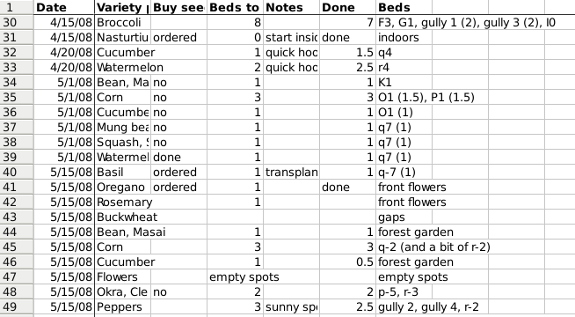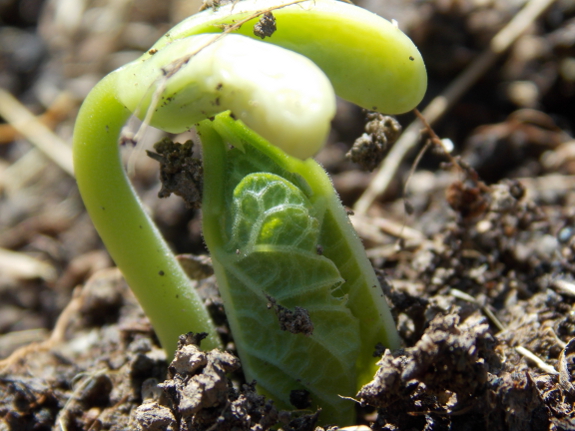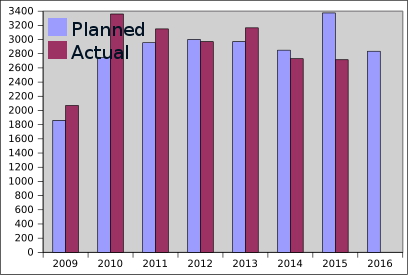
Planning a garden to feed a family of two all year

If you push the garden
envelope with freeze protection and indoor seed-starting, then January
is the time to plan out the growing year. After all, we'll be putting
our first seeds in dirt on February 1!
 I
keep a separate spreadsheet each year for my plan and for my actual
garden plantings. This technique makes it easy to copy and paste last
year's plan into next year's spreadsheet, at which point I take a good
hard look at which plantings worked out and which didn't. If I'm smart, I
also insert notes into the spreadsheet as the garden year progresses
--- simple reminders like "Plant tomatoes inside 3/15 instead of 3/1
next year" make a huge difference nine months later when the time comes
to get the my spreadsheet in order. But sometimes I just remember that
succession planting summer squash every two weeks was really too much
--- once a month would be quite sufficient.
I
keep a separate spreadsheet each year for my plan and for my actual
garden plantings. This technique makes it easy to copy and paste last
year's plan into next year's spreadsheet, at which point I take a good
hard look at which plantings worked out and which didn't. If I'm smart, I
also insert notes into the spreadsheet as the garden year progresses
--- simple reminders like "Plant tomatoes inside 3/15 instead of 3/1
next year" make a huge difference nine months later when the time comes
to get the my spreadsheet in order. But sometimes I just remember that
succession planting summer squash every two weeks was really too much
--- once a month would be quite sufficient.
I've uploaded my 2016 plan
just in case you want to use it as a jumping-off point for your own
garden. (One bed is approximately equal to 15 square feet in the
spreadsheet linked to above.) This is for the ambitious gardener who
wants to feed two humans on vegetables that nearly entirely come
from your own land for twelve months out of the year, so please  do scale back if you're a beginner. (The Weekend Homesteader gives tips on which crops are easy to start with if you've never grown a garden before and on designing a bite-size garden.)
do scale back if you're a beginner. (The Weekend Homesteader gives tips on which crops are easy to start with if you've never grown a garden before and on designing a bite-size garden.)
Interestingly, you'll
notice from the square footage chart to the left that we're slowly but
surely scaling back our own garden's planting area. The blue lines are
my winter dreams; the purple lines are that year's reality. Since 2013,
we've been on a slow downward trend despite the fact that we grew masses
of concentrates for the goats last year (meaning our actual harvest was
much larger than ever before). That's the beauty of improving soil
--- you can grow more food in less space with less elbow grease. On the
flip side of the coin, though, if your dirt is impoverished and you
haven't had time to bring it back to life yet, you might need to
increase the square footage recommended on my chart to feed your own
family of two.
Want more in-depth information? Browse through our books.
Or explore more posts by date or by subject.
About us: Anna Hess and Mark Hamilton spent over a decade living self-sufficiently in the mountains of Virginia before moving north to start over from scratch in the foothills of Ohio. They've experimented with permaculture, no-till gardening, trailersteading, home-based microbusinesses and much more, writing about their adventures in both blogs and books.
Want to be notified when new comments are posted on this page? Click on the RSS button after you add a comment to subscribe to the comment feed, or simply check the box beside "email replies to me" while writing your comment.

"After all, we'll be putting our first seeds in dirt on February 1!"
I was always taught "Dirt gets under your nails. Plants grow in soil." :Giggle:
Wendy --- I like the idea of reclaiming the word dirt, personally --- seems more down to earth.
Tim --- I'd love to hear about your grafting experiences! If you're thinking of writing a guest post, our submission guidelines are here. I look forward to seeing what you come up with!
Hi Anna,
Great chart :).
Gonna try to use it myself :).
How big is a 'bed'?
I seem to recall you said it's size once a while ago, but I have now forgotten that detail.
John
NaYan --- Yep, we preheat beds with quick hoops and keep a close eye on soil temperatures. We don't always plant on February 1, but sometimes we do plant lettuce under cover depending on the weather. Lettuce can germinate as low as 35 Fahrenheit.
John --- A bed is roughly 15 square feet. I hope the spreadsheet helps you out!
Hi Anna,
Yes! Your chart is a BIG help :). I see it as detailed instructions as to what to do so you can feed your family all year from your garden :). Right now that is just me, but trading with nearby growers seems like a good thing to promote :). I am eating last year's wild apples stored in a refrigerator :). Yum!
I am also wondering which herbs are part of your herb package.
I recently added dandelion greens to my diet to get myself healthy from a trip to VA. So I am wondering which ones you include as a part of your diet.
warm regards, John